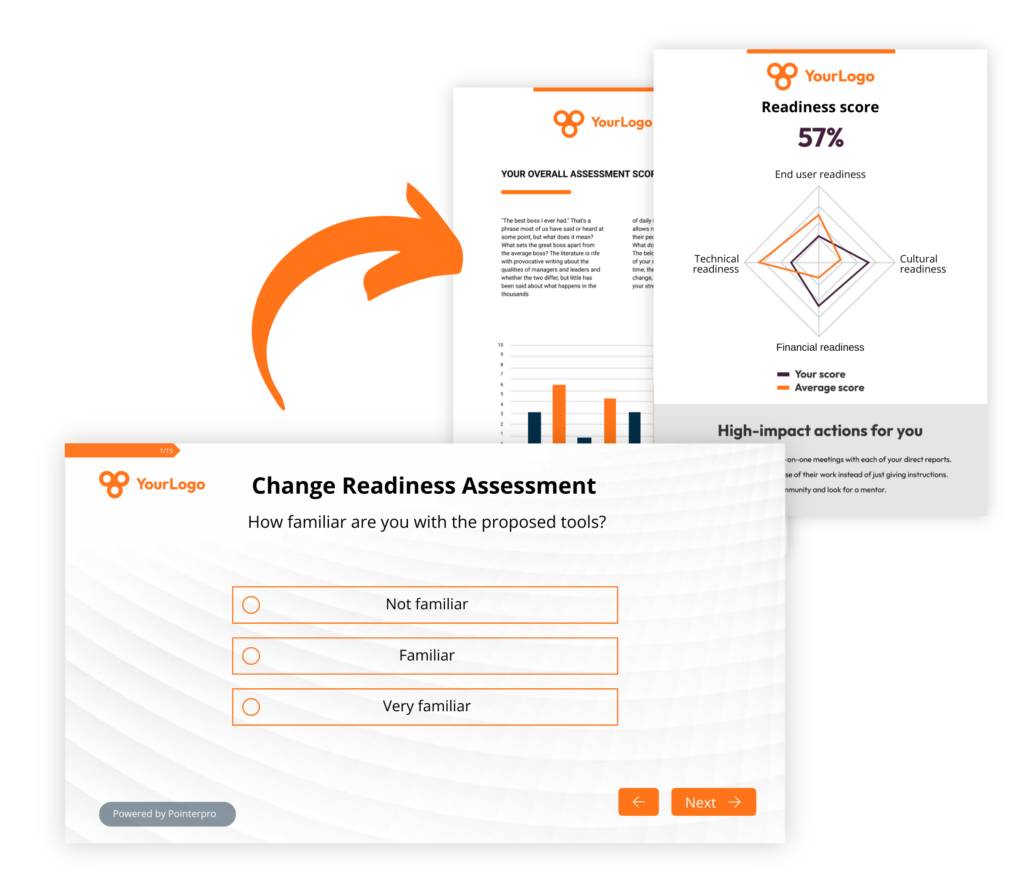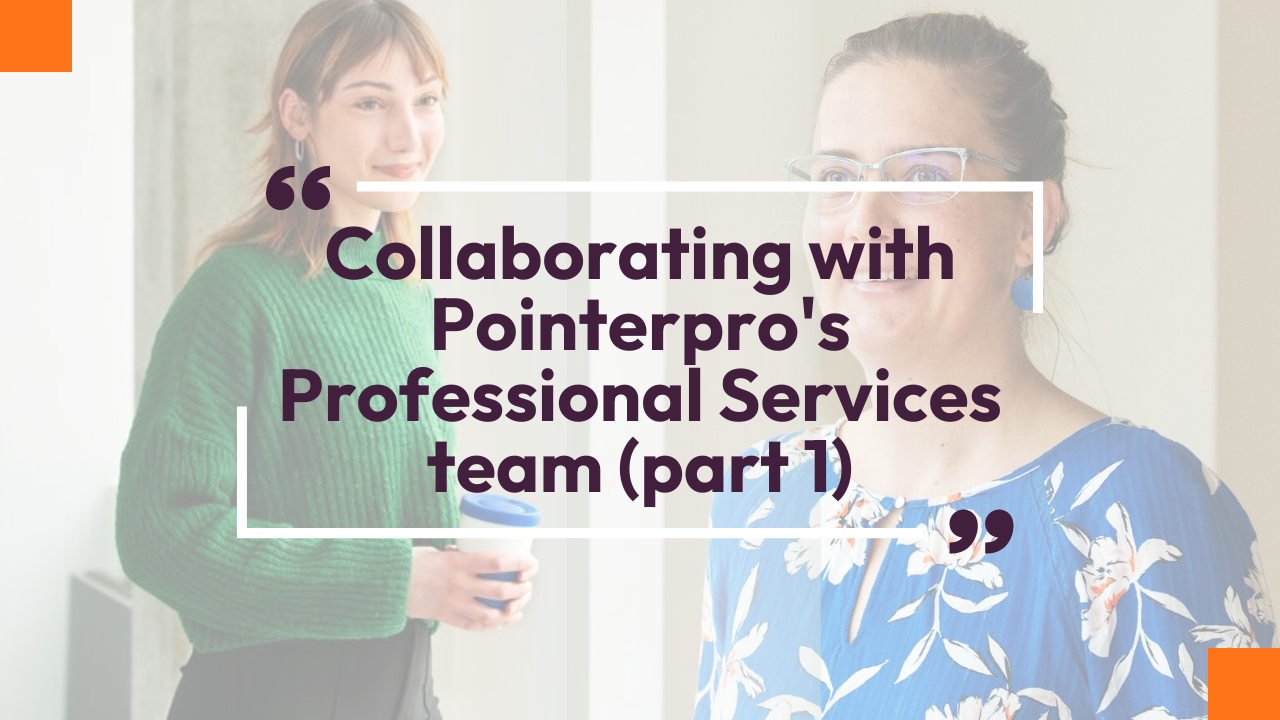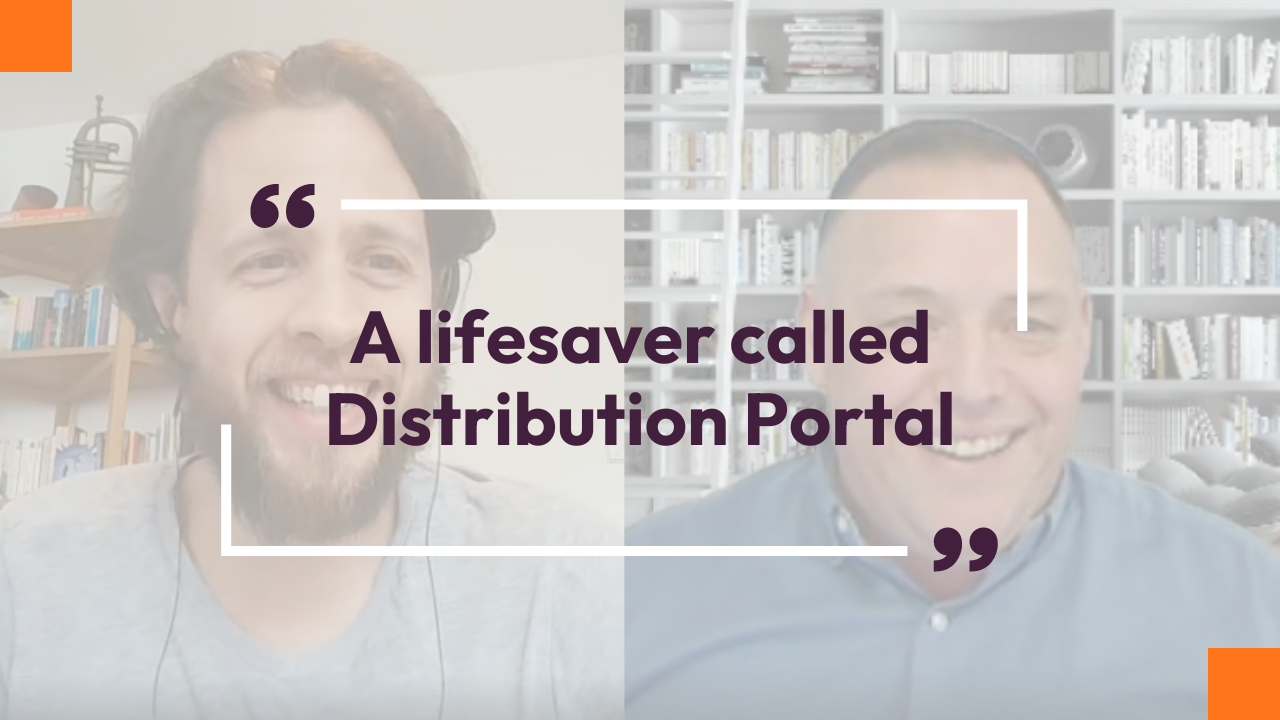Change readiness assessment template
Change management starts with the right assessment of where you are.
But it continues with actionable steps. Advise customers or employees now on autopilot.
Pointerpro is the 2-in-1 software that combines assessment building with personalized PDF report generation.

What is change management?
Change management is a structured approach to transitioning individuals, teams, and organizations from a current state to a desired future state. It involves planning, implementing, and monitoring changes to ensure they are adopted smoothly and sustainably. Effective change management aims to minimize resistance, ensure employee engagement, and achieve the intended benefits of the change.
Assessment is crucial in this process because it provides a clear understanding of the organization’s readiness for change. It identifies potential barriers, strengths, and areas needing support. It’s a crucial first step – but it requires immediate follow-up actions.
Once you’ve conducted a change readiness assessment you need to set up actionable steps. This is crucial for translating insights into strategies. Your steps should provide a clear roadmap for managing the transition, addressing identified gaps, and leveraging strengths to facilitate smooth implementation. Here are three main reasons why establishing actionable steps is so important:
- Clarity and direction: Actionable steps offer a clear plan of action, guiding employees on what needs to be done - but also by whom, and when. This reduces uncertainty and confusion, which tend to be common during periods of change.
- Resource allocation: They help in prioritizing and allocating resources effectively, ensuring that critical areas receive the necessary support and attention.
- Monitoring and adaptation: Concrete steps allow for ongoing monitoring and evaluation. This enables responsible stakeholders to adjust strategies in time, based on real-time feedback and progress.
The quickest and most effective way to set up actionable next steps? Auto-generating personalized feedback reports for every individual stakeholder. And that’s something you can achieve with Pointerpro:
3 reasons to use Pointerpro as a change readiness assessment tool
3 reasons to use Pointerpro as a change readiness assessment tool
Interactive user experience
With the Questionnaire Builder, you get to create an engaging assessment. How? With numerous design and layout options, useful widgets, and countless question types.
Refined, score-based analysis
Our custom scoring engine helps you quantify and categorize diverse answers. The result? An objective and nuanced change readiness assessment that informs the next steps for anyone involved.
Automated feedback in PDF
Thanks to your setup in the Report Builder, respondents get a detailed individual report with personalized and objective feedback. Or you can aggregate results to give stakeholders the big picture.
1.500+ businesses worldwide build assessments with Pointerpro









5 key phases and tools in change management: What is ADKAR by Prosci?
The ADKAR model is a widely used framework in change management – invented by change management authority Prosci. that focuses on five key phases individuals go through during the change process. Each phase represents a building block for successful change, and there are specific tools and techniques associated with each phase:
- Awareness: This phase ensures that employees are aware of the need for change. Effective communication plans, town hall meetings, and awareness campaigns are crucial tools used to build awareness.
- Desire: In this phase, the goal is to foster a desire to support and participate in the change. Employee engagement surveys, motivational workshops, and incentive programs help cultivate this desire.
- Knowledge: This phase focuses on providing employees with the information and training they need to understand how to change. Training sessions, e-learning modules, and knowledge repositories are essential tools for building knowledge.
- Ability: Ensuring employees have the skills and capabilities to implement the change on a day-to-day basis is the focus of this phase. Hands-on training, coaching, and mentoring programs are key tools to develop ability.
- Reinforcement: The final phase aims to sustain the change and prevent a return to old habits. Feedback systems, performance metrics, and recognition programs are critical tools used to reinforce and sustain the change.
By focusing on these five phases, the ADKAR model helps organizations manage the human side of change, ensuring that transitions are smooth and that changes are successfully adopted and sustained.
Digital tools for more effective change management
As a matter of fact, an assessment tool (with automated report generation) comes in handy in many of the different phases of change management.
A change readiness assessment may actually consist of multiple sub-assessments to measure different things – for instance, individual motivations to change (or not to change), but also specific compliance risks or skill gaps to just name a few. All of those assessment results can then be aggregated in a full final report for top stakeholders.
In the video below, one of our colleagues discusses the ADKAR change model and some digital tools that come in handy throughout the change management process:
Change management plan vs change readiness assessment template
In the realm of organizational change, there’s often confusion between a change management plan and a change readiness assessment template. While both are crucial for successfully navigating transitions, they serve distinct purposes and are used at different stages of the change process. Understanding the differences can prove to be useful. Here’s an overview:
Change management plan:
- Purpose: A change management plan is a comprehensive document that outlines the strategies, activities, and responsibilities for managing change within an organization.
- Components: It typically includes objectives, scope, key stakeholders, communication strategies, training plans, timelines, resources, risk management, and metrics for success.
- Focus: The plan is action-oriented, detailing how the change will be implemented, managed, and monitored. It provides a roadmap for the entire change process.
- Usage: It is used throughout the lifecycle of the change initiative to guide the execution and ensure alignment with the overall goals.
Change readiness assessment template:
- Purpose: A change readiness assessment template is a tool used to evaluate an organization’s preparedness for change.
- Components: It usually includes questions or criteria to assess various factors such as organizational culture, stakeholder engagement, current capabilities, potential resistance, and resource availability.
- Focus: The assessment is diagnostic, aiming to identify strengths, weaknesses, opportunities, and threats related to the change initiative. It provides insights into the organization's readiness and areas needing attention before proceeding.
- Usage: It is typically used at the beginning of the change process (and sometimes at intervals) to gauge readiness and later on inform the development of the change management plan.
In summary, a change management plan is an actionable guide for implementing change, while a change readiness assessment template is a diagnostic tool used to evaluate how prepared an organization is for the change. The insights gained from the readiness assessment inform and shape the change management plan.
How to digitize your own change readiness assessment template for change enablement
Digitizing your own change readiness assessment template involves transforming your paper-based change management model into questions, and ultimately into a digital tool that evaluates answers based on a score-based logic. Here are the key steps:
- Define objectives: Clearly outline the purpose and objectives of your change readiness assessment. Determine the key questions you need to ask to gather relevant data and insights. Also determine the best question logic and the weight you want to attribute to different questions and answer options. Lastly, indicate which questions should be grouped together into sub-categories to measure specific aspects of change readiness (E.g. cultural readiness, technical readiness, knowledge-based readiness…)
- Select a digital platform: Choose a digital platform or tool to host your assessment. Crucial here is to find a digital platform or combination of tools that allow you to streamline advice, based on the outcomes of the assessment. Pointerpro offers these capabilities all in one platform.
- Design the assessment: Create the digital version of your assessment questionnaire. Structure it in a user-friendly format with clear instructions and intuitive navigation. Ensure that the questions align with your objectives and cover all relevant aspects of change readiness.
- Customize question types: Use various question types offered by the digital platform, such as multiple-choice, Likert scale, open-ended, or ranking questions, to capture diverse responses effectively.
- Incorporate logic and branching: Implement logic and branching features to tailor the assessment experience based on respondents' answers. This ensures that participants only see questions relevant to their circumstances, streamlining the process and improving engagement.
- Add multimedia elements: Enhance the assessment by incorporating multimedia elements such as images, videos, or links to additional resources. These can provide context, clarification, or examples related to the questions.
- Test the assessment: Conduct thorough testing of the digital assessment to identify and address any technical issues, ensure functionality across different devices and browsers, and validate the clarity and coherence of the questions.
- Iterate and improve: Once you’ve launched officially, gather feedback on the assessment process and outcomes, and use it to iterate and improve future assessments. Continuously refine your digital change readiness assessment template based on lessons learned and evolving organizational needs.
By following these steps, you’ll have an effective change readiness assessment. One that will enable a more efficient, scalable, and data-driven approach to understanding and managing organizational change.
Change readiness assessment example questions
Here are 30 change readiness assessment example questions divided into 3 categories
- 10 technological change readiness assessment example questions
- 10 cultural change readiness assessment example questions
- 10 regulatory change readiness assessment example questions
10 technological change readiness assessment example questions
Technological change involves the adoption or upgrade of technology within an organization (or more broadly, in society). It includes the implementation of new software systems, hardware upgrades, or the integration of innovative technologies like artificial intelligence and automation.
- How familiar are you with the new technology we’re planning to implement?
- How confident do you feel about using the new technology effectively?
- Have you received adequate training to use the new technology?
- Do you believe the new technology will improve your workflow?
- How supportive do you feel your team is towards adopting the new technology?
- Are you aware of the resources available to help you learn the new technology?
- How frequently do you encounter issues while using the new technology?
- How comfortable are you seeking help when you face difficulties with the new technology?
- Do you feel that the new technology aligns with your job responsibilities?
- How satisfied are you with the communication about the technological change?
These change readiness assessment template questions are designed to comprehensively assess the readiness and attitudes of employees towards a technological change. They cover familiarity, confidence, training adequacy, perceived impact, team support, resource awareness, issue frequency, comfort in seeking help, alignment with job responsibilities, and satisfaction with communication.
By offering a range of answer options from strongly positive to strongly negative, the assessment would identify areas of strength and concern, providing valuable insights for tailoring support and resources to ensure a smooth and successful transition to the new technology.
10 cultural change readiness assessment example questions
Cultural change in a professional context refers to shifts in the collective behaviors, values, norms, and practices within an organization. This can be driven by initiatives to improve diversity and inclusion, changes in leadership, or broader social movements.
- How well do you understand the new cultural values being introduced?
- How aligned do you feel with the new cultural values?
- Have you observed changes in behavior that reflect the new cultural values?
- How comfortable do you feel expressing your opinions in the new cultural environment?
- Do you feel that the new cultural values have improved team collaboration?
- How supportive is leadership in reinforcing the new cultural values?
- Have you participated in any training or workshops related to the new cultural values?
- How has the new culture impacted your daily work activities?
- Do you feel that the new cultural values are inclusive and diverse?
- How satisfied are you with the communication regarding the cultural change?
These change readiness assessment template questions are designed to gauge employees’ understanding, alignment, and perception of a cultural change within the organization. They assess awareness and comprehension of new cultural values, observed behavioral changes, comfort levels, impact on teamwork, leadership support, participation in related training, and overall impact on daily work activities. Additionally, they evaluate perceptions of inclusivity and satisfaction with communication efforts.
By providing a range of response options, this assessment would identify both strengths and areas needing improvement, offering a comprehensive view of the cultural shift and guiding further actions to reinforce and sustain the desired culture.
10 regulatory change readiness assessment example questions
Regulatory change involves adjustments to laws, regulations, or policies that organizations or must comply with. This can include changes in industry standards, government regulations, or compliance requirements.
- How aware are you of the new regulatory requirements affecting your role?
- How well do you understand the impact of the new regulations on your daily tasks?
- Have you received adequate training on the new regulatory requirements?
- How confident are you in your ability to comply with the new regulations?
- Do you have access to the necessary resources to comply with the new regulations?
- How often do you encounter challenges related to the new regulatory requirements?
- How supportive is your management in helping you understand and comply with the new regulations?
- Do you believe the new regulations will benefit the organization in the long run?
- How effectively has the organization communicated the changes in regulatory requirements?
- How satisfied are you with the tools and systems in place to support compliance with the new regulations?
These questions are designed to assess employees’ awareness, understanding, and preparedness for regulatory changes affecting their roles. They cover knowledge of the new requirements, adequacy of training, confidence in compliance, availability of resources, frequency of challenges, management support, perceived benefits, communication effectiveness, and satisfaction with compliance tools and systems.
The response options could range from strongly positive to strongly negative, providing a nuanced view of the organization’s readiness and areas needing improvement. This comprehensive assessment helps identify gaps and informs targeted actions to ensure compliance and smooth adaptation to the new regulatory landscape.
What Pointerpro clients are saying




9 more change readiness assessment or management models for your inspiration
- Lewin's Change Management Model: Developed by Kurt Lewin, this model consists of three stages: unfreezing, changing, and refreezing. Unfreezing involves preparing for change, changing involves implementing the change, and refreezing involves stabilizing the change and making it permanent.
- Kotter's 8-Step Change Model: Proposed by John Kotter, this model outlines eight steps for implementing change effectively, including creating a sense of urgency, building a guiding coalition, and anchoring changes in the organization's culture.
- McKinsey 7-S Model: Developed by McKinsey & Company, this model identifies seven interdependent factors that must be aligned for organizational success: strategy, structure, systems, shared values, style, staff, and skills.
- Bridges' Transition Model: William Bridges' model focuses on the psychological transitions individuals experience during change. It consists of three stages: ending, neutral zone, and new beginning, and emphasizes the importance of managing people's emotions and reactions during each stage.
- The Satir Change Model: Developed by Virginia Satir, this model identifies five stages individuals go through during change: late status quo, resistance, chaos, integration, and new status quo. It emphasizes the need for open communication and support to navigate these stages successfully.
- Kübler-Ross Change Curve: Adapted from Elisabeth Kübler-Ross's stages of grief, this model describes the emotional stages individuals go through during change: denial, resistance, exploration, and commitment. It helps leaders understand and address employees' emotional reactions to change.
- The Bridges Transition Model: William Bridges' model focuses on managing transitions rather than change. It identifies three phases: endings, neutral zone, and new beginnings, emphasizing the importance of supporting individuals through the emotional and psychological aspects of change.
- Kepner-Tregoe's Change Management Model: This model emphasizes problem-solving and decision-making processes during change. It involves defining objectives, identifying potential obstacles, developing action plans, and monitoring progress to ensure successful implementation.
- GRPI Model (Goals, Roles, Processes, Interpersonal Relationships): This model focuses on addressing key components necessary for effective team performance during change. It emphasizes clarifying goals, defining roles, optimizing processes, and fostering positive interpersonal relationships to facilitate successful change implementation.
In navigating the complex landscape of organizational change, the most effective approach often involves crafting a tailored model that draws inspiration from collective knowledge and best practices while remaining uniquely aligned with the specific needs and dynamics of the organization or client.
While established change management models offer valuable frameworks and insights, they should serve as guiding principles rather than rigid templates. By customizing a model to fit the organization’s culture, goals, and challenges, leaders can foster a deeper sense of ownership and commitment among stakeholders, ultimately enhancing the likelihood of successful change adoption and sustainable outcomes.
This approach acknowledges the importance of leveraging existing expertise while embracing the individuality of each change initiative, empowering organizations to navigate change with agility, resilience, and purpose.
Create your change readiness assessment today
You may also be interested in
Recommended reading

Vlerick Business School digitalizes entrepreneurship development with Pointerpro [case study]
What do a top-tier international business school based in the capital of Europe and Pointerpro have in common? At the

Attain Global: How to do psychometric tests right and build a cutting-edge international business [case study]
In many countries worldwide, the pursuit of skillful and engaged employees is not so much a war on talent as

How youth development specialist Halogen reaches thousands of young Singaporeans with Pointerpro [case study]
Singapore, in Southeast Asia, is a global, economic powerhouse with a population of a little less than 6 million people.


